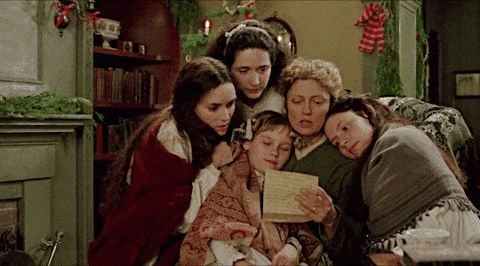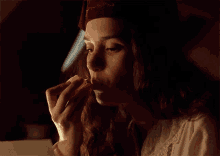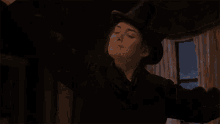Lunatics, vampires... this interests you?
On Little Women, writerly ambitions and Jo March as a queer and neurodivergent icon!
Once upon a time I thought I would like to write high-minded literature in the vein of Little Women, full of virtuous ladies and moral lessons. But, in practice I’ve found that it’s much more fun to write about lunatics and vampires, as well as ghosts, ghouls, witches, fairies and other occult or folk entities and oddities.
Welcome to AutCasts, a free bi-weeekly newsletter exploring neurodivergence through cinema’s oddballs, misfits & rebels!
Jo March begins her writing career selling just these kinds of stories to the penny presses of New England, until her future husband (or in Luisa May Alcott’s case, her publisher) encouraged her to produce more “worthy” stories, “written from the heart.”Though many high-minded literary journals continue to dismiss the speculative or the supernatural as genre fiction and lacking in literary merit, unless, of course, you are Carmen Maria Machado. I would argue, however, that writing from the heart does not preclude writing about lunatics or vampires, it can be quite the opposite, especially if you are Carmen Maria Machado.
With the first (and possibly only) snow of the Irish winter to have come exceptionally early, but just in time for my (40th!!) birthday tomorrow, what better way to welcome the holiday season season than to cozy up at the fireside with Little Women. And my favourite, of the many adaptions, remains the 90s classic staring not one, not two, but three of my tweenage crushes: Winona Ryder (Jo), Clare Danes (Beth) and Kirsten Dunst (Amy).
Little Women is a 1994 American coming-of-age historical drama film directed by Gillian Armstrong. The screenplay was written by Robin Swicord and is based on Louisa May Alcott's 1868–69 autobiographical novel of the same title. Little Women recounts the life of the March sisters in Concord, Massachusetts during the 1860s. With their father fighting in the American Civil War, sisters Jo, Meg, Amy and Beth are at left home with their mother Marmi (Susan Sarandon) a proto-feminists who gives the girls incredible freedom for the time. As Jo works towards a writing career her sisters pursue knowledge, music, art and love.
As a child I inherited my mother’s copy of Little Women. A 1960’s hardcover edition with a faded illustration of the March sisters on the front and pages yellowed with age. It had that wonderful smell of old paper. I lost count of how many times I read it in the near dark of my childhood bedroom, wishing to have Jo’s guts and creativity but feeling like I would never be good enough to write anything other people might want to read.
Though my mother held on to many of her own possessions from childhood, including the aforementioned copy of Little Women, an old doll and some barbies with their handmade shift dresses, she did not extend the same kind of sentimentality to her children’s possessions. And somehow, that beloved copy of Little Women, got lost in one of the many purges of children’s toys and books given away to good will.
I haven’t been able to bring myself to read another edition of Little Women, as if the feeling, if not the content, will not be matched in a modern print. But I have, on repeated occasions, and especially around this time of year when the nights are drawing in and snow flurries fall from the sky, watched the 1994 adaptation.
I was ten years old when Little Women came out, 30 years ago this December. It was the perfect age to get swept up in the minor and major dramas of the March sisters: Amy’s quest for limes, Jo’s plays performed in their attic, Meg’s feelings of inadequacy around other girls and Beth’s illness and untime death which, even though I know it’s coming, always makes me cry. Like many movies covered in this newsletter Little Women became a staple at my friends’ slumber parties throughout my teens. And Jo, whether on the page, or Winona Ryder’s 1994 incarnation, is a character I both adored and aspired to be. It is only in recent years, however, that I realised that the characteristics which most drew me to her had echoes of queerness and, dare I say it, neurodivergence.
My mind would come alive…
Jo is creative, impulsive, obsessive and the least amenable of the March sisters. She has neither the looks of Amy nor the sense of Meg nor the agreeableness of Beth. Yet the reader or viewer is invited to fall in love with her and her determination to pursue a life of creativity despite the limitations placed on her gender and (relative) poverty. She writes, with a voice over in the movie, how:
‘Late at night my mind would come alive with voices and stories and friends as dear to me as any in the real world. I gave myself up to it, longing for transformation.’
This nocturnal world of imagination, reflects my own insomniac tendencies where my most expansive ideas and best writing often happens while the rest of the world is asleep. I have experienced sleep disruption, if not insomnia, since I was a child and until I met Jo, I thought this was just another of my abnormalities. But to see Winona as Jo, with her ink-stained hands, writing by candlelight until the early hours of the morning, her resistance to getting up early, as expected, is like watching myself, even now, trying to be a writer.
Jo was the blueprint for many young girls who felt kinship with her creative spirit in a literary world often lacking relatable heroines. And, as a woman, Jo struggles to be taken seriously as a writer, until she passes herself as male — changing her pen name from Josephine to Jo — and modifies her ‘too feminine' script. It would be nice to think the publishing world has improved, and while gains certainly have been made, it remains a very male and white space. Women’s writing still not taken as seriously as men’s and people of colour, queer or disabled folks, still struggle to get a foot in the door or tell the stories they want to tell, rather than stories publishers think will sell.
I want to change but…
Jo’s single-mindedness and flouting of convention make her stand out among her sisters and wider community. Jo is not fussed about her appearance, the conventions of being a lady, what other people might think of her, nor the expectations imposed on her gender. She regularly cross-dresses in her plays and at one point longs to be a boy, just like Lorrie (Christian Bale). But this brings its own challenges. She exclaims to Marmi in a moment of frustration:
‘I’m ugly, and awkward and I always say the wrong thing (…) there’s just something really wrong with me, I’ll never fit in. I want to change but I can’t.’
If ever there was one phrase, on print or on screen, that summed up how I felt about myself as a teenager and young adult it would be this. Jo is caught between the drive to stay true to herself and the tension or distress this causes in her life, particularly when she clashes with the expectations of family or friends or loses out on opportunities. This is contrasted with the almost angelic Amy who is beautiful, amenable and determined to use these traits to rise above her family’s impoverished state.
The only person who seems to understand Jo, is her mother, Marmi who provides comfort and never pushes Jo into the ideals of femininity aspired to by almost all the other women that surround her. Marmi herself, is also a non-conformist bad-ass, who refuses to make her daughters behave in line with the gendered restrictions imposed on young women of the day. She provides lectures (info-dumps?) about corsets, is an abolitionist and believes in giving her daughters the freedom to explore their desires, regardless of whether those desires include marriage.
Why do we have to get married at all?
Jo’s inconformity extends beyond feminine expectations, to the institution of marriage itself. She asks, as Meg is wooed with increasing intention by Lorrie’s tutor: ‘Why can’t things just stay the same?’ In her idyllic home life with minimal interference from men, Jo would happily continue living surrounded by her sisters (or perhaps other women?) without interruption. But the demands of real life, as well as growing pains, begin to show.
Though my home life was less than idyllic, I certainly resonated with the sentiment of wanting things to stay the same. The transition from child to teenager was particularly painful as a large part of me wished to stay in the world of fantasy and make-believe where my closest companions were books or toys. It was a shock to go from playing with Barbies to navigating the minefield of social norms and expectations that teenage girls, of all generations, must grapple with, as well as the pressure to develop romantic interest in boys.
Jo’s rejection of marriage is so steadfast that the proposal from her best friend, Lorrie, is felt as a tragedy, rather than a blessing. Jo is distraught to realise they want very different things in life and that her openness towards him has been deeply misunderstood as romantic interest.
Jo’s eventual marriage to Frederick (a disturbingly old Gabriel Byrne - 44 to Ryder’s 23) is a deeply dissonant note in the book/movie. As a child, who was deeply aware of how marriage could prejudice women, Jo’s marriage felt like a terrible betrayal. How could she give in, I used to think, and to Frederick not Lorrie? It was not until I learned that Louisa May Alcott, who herself never married, was obliged by her editors to invent a suitor for Jo and marry her off, that this made some kind of sense. It is a sad reflection of the standards of the day, that an unmarried protagonist would be unacceptable. But these tensions, on and off the page/screen only give us queers more room for speculation about the sexual inclinations of the author and her beloved protagonist.
Postcript
It was fascinating to learn that, despite its instant success, this adaption of Little Women almost never happened. “Women’s movies”, unless they were rom-coms had, and continue to have, little support, with studio executives repeatedly failing to realise that women enjoy and pay to see movies too! In fact, it was Winona Ryder — the superstar of the time — and her interest in the project that finally convinced the studios to finance the movie. I highly recommend this oral history of the project, featuring all significant participants, for more insights and trivia on how Little Women came to be, including wigs lighting on fire and sweating through corsets.
There is never a shortage of commentary about Louisa May Alcott’s life and writing, the contradictions between the two, debates over whether Little Women can be considered a feminist text or not and Jo’s status as a queer icon. I particularly appreciated this
essay from The Paris Review back in 2019, where she goes beyond the passive, almost angelic, portrayal of Beth in the book and the movie, to explore the life of the real sister, Lizzie, who Luisa lost to scarlet fever but who did not let herself go gently into the night.Rewatching the movie recently, I realised that the writer in me still aspires to be a Jo March: vampires, lunatics and all. I wonder how much of my personality is rooted in Jo’s DNA, those nights reading Little Women in the semi-dark and if I too could ever be a published novelist?
If you liked what you read, please tap the heart 💕 below and consider subscribing (for free) or sharing this essay. As an independent writer it’s the best way to support my work!








Really enjoyed that piece. Lots I never knew.... and totally identify with her writing time table. Who needs mornings? J
Jo as neurodivergent really makes sense! This takes me back! LOL at (info-dumps?) about corsets”! It’s also giving me an idea for vampire Little Women (although maybe it’s been done!)
I think I watched the black and white version… 😅 I remember being inspired by the play they produced at home.
In terms of the sequel, I still quote the observation from Amy (?) about chandeliers!